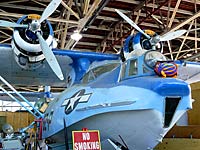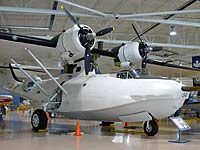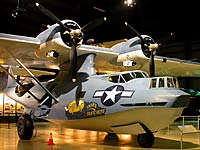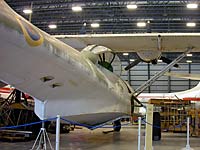| page 1 of 2 |
| Floyd Bennett Field - HARP - Consolidated PBY Catalina Flying Boat
Bill Maloney 3/4/2009 |
| page 1 of 2 |
Consolidated PBY Catalina Variants at other Aviation Museums |
|
 |
 |
| Another PBY Catalina can be found at the American Air Power Museum in Farmingdale, NY | Consolidated PBY Canso at the Canadian Warplane Heritage Museum in Mount Hope, Ontario, Canada |
 |
 |
| PBY Catalina at the US Air Force Museum in Dayton, OH | Consolidated PBY Canso at the Canadian Aviation Museum in Ottawa, Ontario, Canada |
Length: 63 feet, 10 inches
Wingspan: 104 feet, 0 inches
Height: 20 feet, 1 inch
Crew: 9
Weight: Empty - 6,500lbs Max Takeoff - 36,400lbs
Max Speed: 174mph at 7,000 feet
Cruise Speed: 120 mph
Range: 2,325 miles
Service Ceiling: 22,400 feet
Fuel Capacity: 1,750 gallons internally
Powerplant: Two Pratt & Whitney R-1830 Radial engines 1,200 hp each
Armament:
2 50cal Browning Machine Guns in flexible waist positions
2 30cal Browning Machine Guns, one in the nose turret, the other in a rear ventral hatch
Up to 8,000lbs of bombs externally
First Flight: March 20, 1935
Cost: $90,000
This particular PBY was donated to the museum by the United States Marine Corps in return for it being restored and put on display in Marine Corps livery. Much work has already been done, stripping paint and treating areas of corrosion, and removing and replacing aluminum skin panels that were too badly corroded to be left in place. There is still much to do but it was interesting to see internal structural details that would otherwise not be visible.
As well as being a fabled naval reconnaisance and rescue aircraft, the PBY Catalina was used by the Cousteau Society. Philippe Cousteau had loved flying their PBY. Unfortunately he was killed in their Catalina in a flying accident. While doing a high speed taxi test run in the Tagus river in Portugal in 1979, the PBY struck a submerged sand bar. The impact caused the aircraft to nose over and flip onto its back. The wing broke free from the fuselage and the left Pratt & Whitney sheared off its mount. The engine or more likely the propeller came though the pilot's side of the cockpit, killing Philippe. Cousteau was the only fatality out of 8 on board. The Catalina was a complete write off.
Floyd Bennett Field - HARP Main Page
Military & Aviation Museums Main Page